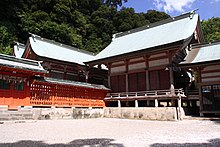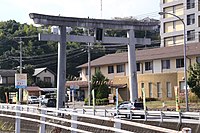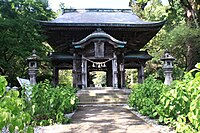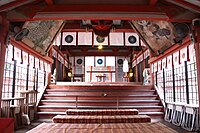| Yusuhara Hachiman-gū 柞原八幡宮 | |
|---|---|
 Shaden of Yusuhara Hachiman-gū Shaden of Yusuhara Hachiman-gū
| |
| Religion | |
| Affiliation | Shinto |
| Deity | Hachiman |
| Festival | March 15 |
| Location | |
| Location | 987 Yawata, Ōita-shi, Ōita-ken |
  | |
| Geographic coordinates | 33°14′18.2″N 131°33′3.6″E / 33.238389°N 131.551000°E / 33.238389; 131.551000 |
| Architecture | |
| Style | Hachiman-zukuri |
| Date established | c.830 |
| Website | |
| Official website | |
Yusuhara Hachiman-gū (柞原八幡宮) is a Shinto shrine located in the city of Ōita, Ōita Prefecture, Japan. It is one of two shrines claiming the title of ichinomiya of former Bungo Province, the other being the Sasamuta Jinja, also in Ōita. The shrine's main festival is held annually on March 15. It is also sometimes referred to as Yusubara Hachiman-gū (由原八幡宮).
Enshrined kami
The main kami at this shrine is Hachiman (八幡), here identified as the trinity of Emperor Chūai, Emperor Ōjin and Empress Jingū.
History
The foundation date of this shrine is unknown. The shrine's legend, which dates from the Kamakura period states that in the year 827, a monk of Enryaku-ji named Konki worshipped at Usa Hachiman-gū for 1000 days and received an oracle which stated that the kami Hachiman would bless Bungo Province. A mysterious white banner flew over Kakugo, Ōita and was presented to Emperor Ninmyo, who ordered the governor of Bungo Province to construct this shrine. From the year 998 onwards, it became the practice to reconstruct the shrine buildings at 33 year intervals, the same as at Usa Hachiman-gū. Despite its dispute with Sasumuta Jinja, which as an equally ancient claim to the title, it has been referred to as the "Bungo ichinomiya since the 12th century, because of the shrine's proximity to the kokufu of Bungo Province. The shrine was supported by the Ōtomo clan from the time they entered the province as shugo during the Kamakura period. In the Sengoku period, it was destroyed by Ōtomo Sōrin after his conversion to Christianity, but was rebuilt in the early Edo period and supported by the successive daimyō of Funai Domain. Following the Meiji Restoration, it was given the rank Prefectural shrine under the Modern system of ranked Shinto Shrines. In 1912, it was promoted to a National Shrine, 3rd rank (国幣小社, Kokuhei Shosha) .
Gallery
Cultural properties
Natural Monuments
- Camphora officinarum, National Natural Monument. Claimed to be over 3000 years old. Mentioned by Ino Tadataka in his 1811 survey of Japan
Important Cultural Properties
- Yusuhara Hachiman-gu (10 structures), Edo Period.
- Honden, 1850
- Mōshidono, 1752
- Haiden, 1759
- Rōmon, 1760
- Tōhōden, 1757
- Saihōden, 1757
- East Corridor, 1798
- West Corridor, 1798
- West Gate, late Edo Period
- South Great Gate, 1870, with storehouse including 4 documents: blueprints for Main Shrine and Rōmon, 2 maps of precincts)
- Tachi sword, Kamakura period, inscribed "Kunimune"
- Tachi sword, Kamakura period, inscribed "Minamoto no Kuni?"
- Halberd, Nanboku-chō period, inscribed "Kunishige" and "Hachiman Daibodhisattva Tenma Daijizai Tenjin"
- Bronze Buddha statue, Asuka period.
- Armor, complete set, Muromachi period,
- Yusuhara Hachiman-gu old documents, Heian period, 17 scrolls with 216 documents.
See also
References
- "Nationwide List of Ichinomiya," p. 1.; retrieved 2011-08-010
- Shibuya, Nobuhiro (2015). Shokoku jinja Ichinomiya Ninomiya San'nomiya (in Japanese). Yamakawa shuppansha. ISBN 4634150867.
- Yoshiki, Emi (2007). Zenkoku `Ichinomiya' tettei gaido (in Japanese). PHP Institute. ISBN 4569669301.
- Okada, Shoji (2014). Taiyō no chizuchō 24 zenkoku `Ichinomiya' meguri (in Japanese). Heibonsha. ISBN 4582945619.
- "柞原八幡宮のクス" (in Japanese). Agency for Cultural Affairs. Retrieved 20 August 2023.
- "柞原八幡宮" (in Japanese). Agency for Cultural Affairs. Retrieved 20 August 2023.
- "太刀〈銘国宗/〉" (in Japanese). Agency for Cultural Affairs. Retrieved 20 August 2023.
- "太刀〈銘源国(以下一字竝年号不明)/〉〉" (in Japanese). Agency for Cultural Affairs. Retrieved 20 August 2023.
- "薙刀直シ刀〈銘国重八幡大菩薩天満大自在天神/〉" (in Japanese). Agency for Cultural Affairs. Retrieved 20 August 2023.
- "銅造仏像(社伝阿弥陀如來立像)" (in Japanese). Agency for Cultural Affairs. Retrieved 20 August 2023.
- "白檀塗浅葱糸威腹巻〈兜・大袖・小具足付/〉" (in Japanese). Agency for Cultural Affairs. Retrieved 20 August 2023.
- "柞原八幡宮文書(二百十六通)" (in Japanese). Agency for Cultural Affairs. Retrieved 20 August 2023.
External links
| Shinto shrines | |||||||||||||||||||||||||||||
|---|---|---|---|---|---|---|---|---|---|---|---|---|---|---|---|---|---|---|---|---|---|---|---|---|---|---|---|---|---|
| |||||||||||||||||||||||||||||
| |||||||||||||||||||||||||||||




